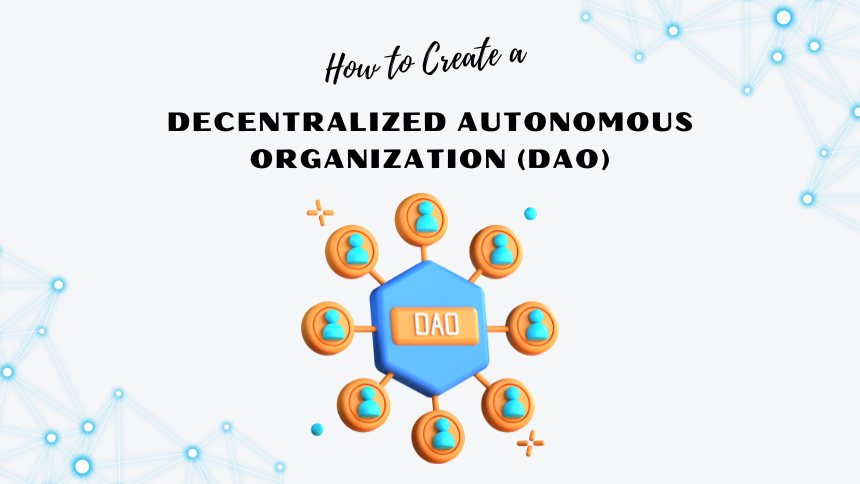Decentralized autonomous organizations are a new type of organizational structure that operates autonomously and transparently, without the need for traditional centralized management. In this guide, we’ll explore the fundamentals of creating a DAO, providing step-by-step instructions to help you navigate this innovative and decentralized approach to governance.
Understanding Decentralized Autonomous Organizations (DAOs):
A Decentralized Autonomous Organization (DAO) is a type of organization that operates entirely on the blockchain, using smart contracts to automate decision-making and governance processes. Unlike traditional organizations, DAOs are not controlled by a central authority or management team. Instead, they are governed by code and executed by the collective actions of their members, known as token holders.
Benefits of Decentralized Autonomous Organizations (DAOs):
DAOs offer several advantages over traditional organizational structures, including:
- Decentralization: Decentralized Autonomous Organizations (DAOs) eliminate the need for intermediaries and central authorities, allowing for greater transparency, efficiency, and resilience.
- Transparency: All transactions and decisions within a DAO are recorded on the blockchain, providing complete transparency and accountability to its members.
- Autonomy: DAOs operate autonomously according to pre-defined rules and smart contracts, reducing the need for human intervention and minimizing the risk of corruption or manipulation.
- Inclusivity: DAOs are open to anyone with access to the internet, allowing individuals from around the world to participate and contribute to the organization’s decision-making process.
- Flexibility: DAOs can be customized to suit a wide range of use cases and industries, from decentralized finance (DeFi) and governance to supply chain management and social organizations.

Steps to Create a Decentralized Autonomous Organization (DAO):
Creating Decentralized Autonomous Organizations (DAOs) involves several key steps, including:
Define the Purpose and Scope:
Before creating a DAO, clearly define its purpose, objectives, and scope. Determine the problem or need it aims to address and identify the stakeholders and potential members who will participate in the organization.
Choose a Blockchain Platform:
Select a suitable blockchain platform to deploy your DAO. Ethereum is the most commonly used platform for creating Decentralized Autonomous Organizations (DAOs), thanks to its robust smart contract functionality and large developer community. Other platforms like Polkadot, Tezos, and Binance Smart Chain also support Decentralized Autonomous Organizations (DAOs) creation.
Design Smart Contracts:
Develop smart contracts that govern the operations and decision-making processes of your DAO. These smart contracts should define the rules for membership, voting mechanisms, fund management, and dispute resolution.
Token Distribution:
Determine the token distribution mechanism for your DAO. Tokens are used to represent ownership and voting rights within the organization. Consider factors such as tokenomics, token issuance, distribution methods, and incentives for participation.
Launch and Governance:
Once the smart contracts are deployed and the tokens are distributed, launch your DAO and begin governance operations. Establish procedures for proposing and voting on decisions, managing funds, and resolving disputes within the organization.
Community Engagement:
Encourage community participation and engagement to foster a vibrant and active ecosystem around your DAO. Provide channels for communication, collaboration, and feedback to ensure that members have a voice in the organization’s direction and decision-making process.
Challenges and Considerations:
While Decentralized Autonomous Organizations (DAOs) offer many benefits, they also present several challenges and considerations, including:
Regulatory Compliance:
Navigate regulatory requirements and legal considerations associated with operating a Decentralized Autonomous Organization (DAOs) in your jurisdiction.
Security Risks:
Mitigate security risks associated with smart contracts, including vulnerabilities, exploits, and hacks.
Governance Issues:
Address governance challenges such as voter apathy, plutocracy, and collusion, and implement mechanisms to promote fairness and inclusivity in decision-making.
Conclusion:
Creating a Decentralized Autonomous Organization (DAO) is an exciting and innovative endeavor that offers numerous benefits for organizational governance and collaboration. By following the steps outlined in this guide and considering the challenges and considerations involved, you can create a DAO that empowers its members and operates autonomously on the blockchain. With the potential to revolutionize traditional organizational structures, Decentralized Autonomous Organizations (DAOs) represent a promising avenue for decentralized innovation and collaboration in the digital age.
